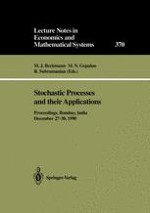1991 | OriginalPaper | Chapter
The Optimal Investment Process in German Industry
Author : Horst Albach
Published in: Stochastic Processes and their Applications
Publisher: Springer Berlin Heidelberg
Included in: Professional Book Archive
Activate our intelligent search to find suitable subject content or patents.
Select sections of text to find matching patents with Artificial Intelligence. powered by
Select sections of text to find additional relevant content using AI-assisted search. powered by
This paper provides an explanation of investment behaviour of German industrial firms. Regarding the actual development of business investment, there are two main problems of interest: (1)its decline between 1970 – 1976,(2)its recovery, first slow between 1976 – 1984, then sudden after 1984.The theoretical framework of our analysis is provided by the Bonn Model of Firm Development, which represents an econometric model of firm growth consisting of 27 equations dependent on each other. Firms are divided into functional sections which act independent from each other and therefore come to globally suboptimal decisions. Data material of annual statements of accounts of 134 German industrial firms yield empirical support of our theory.Two models of business investment are motivated, discussed and tested: In the first model, the cost of the production process are minimized subject to a Cobb-Douglas production function with Hicks-neutral technical progress. Factor inputs react highly elastic to changes in relative factor prices. Factor stocks adjust to their optimal level with high speed. As a consequence, investment behaviour is explained by the investment rate of the previous period, weighted averages of growth rate of sales and weighted averages of growth rate of relative prices for capital goods.Whereas user cost of capital remained relatively stable overtime, wage rates and raw material prices rose significantly. For the reason of revaluation of the deutschmark, relative prices remained rather stable, so that no major investments were undertaken. After 1984, the price indices of factor inputs developed in opposite directions in favour of capital goods prices. As a consequence, investment increased substantially.In the second model, the intertemporal allocation of resources is optimized simultaneously. Capital and labour are treated as quasi-fix factors. The speed of adaptation is considered rather low since reaching the optimal level of factor input stocks is costly. Therefore our cost function is extended to an adaptation cost term. First, this model reveals a complementary relationship between labour and capital. Secondly, the amount of adaptation cost is crucial for the level of employment. In order to achieve full employment, conditions for equity financing have to be improved. To stress the importance of this ”delicious circle” is one fundamental purpose of this paper.
